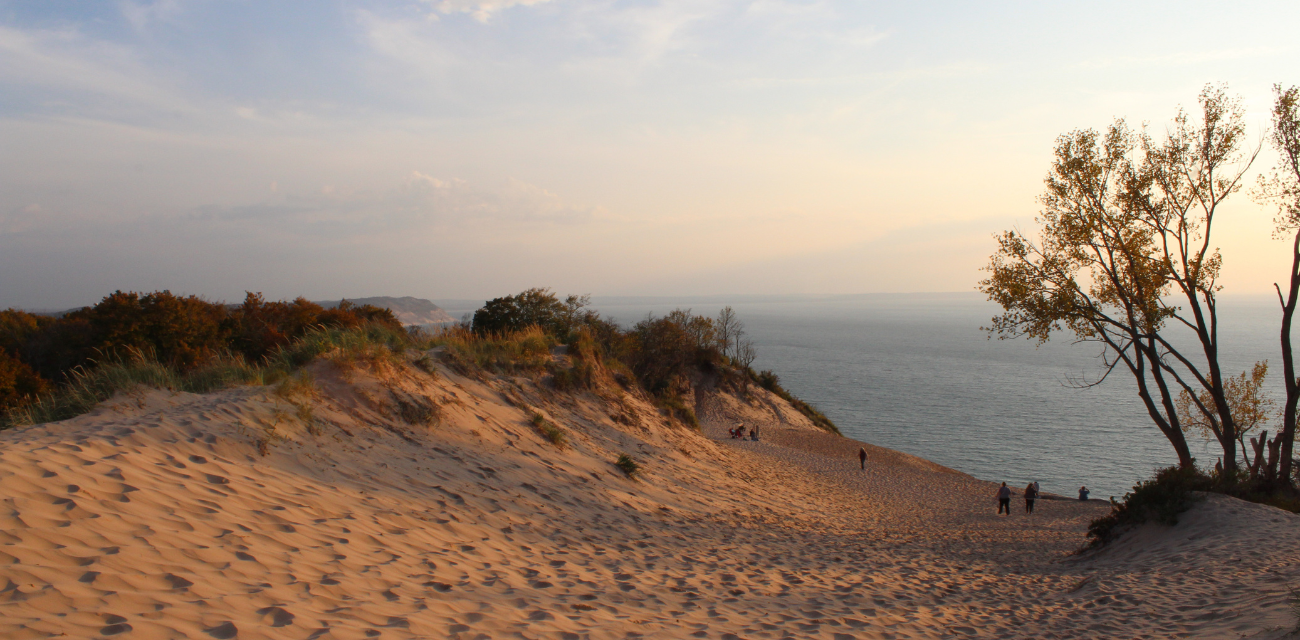For the love of freshwater sunsets

Authored by

Grace Noyola
Every summer I reserve a four-day weekend in August to make a trip to my best friend’s cottage in Norton Shores. Throughout the year, I travel to many places both in-state and beyond. Without doubt, this is the vacation I cherish above all else.
And if you’re a Michigander, you know why. There’s just nothing like watching a sunset—toes in the sand, lake breeze in your face—on the shores of Lake Michigan.
This year I took a little extra care observing as we took our morning walks up and down the shore—one day heading north towards the Muskegon lighthouse, and one day heading south towards the Grand Haven lighthouse. The first thing you notice is the sheer number of steps it takes to get from our campground to the shore. It’s easy going down, not so easy coming up.
But there’s more. If you look closely you’ll see something you just don’t see on most beaches. Huge, mature trees and thick vegetation that run almost vertically up the dunes. Driftwood encapsulated in feet of sand, so deep it doesn’t budge when you stand on it.
When you’ve become so familiar with a place, it’s easy to forget just how special it is.
There’s no place like home
Our little beach is just one slice of an expansive 300 miles of lakeshore across the Lower and Upper Peninsulas that form Michigan’s Critical Dunes Area. It’s the world’s largest freshwater dune system, a globally-rare resource that has come under increased threat these past couple of decades.
These dunes are home to diverse “natural communities,” from open dunes, to Great Lakes barrens and interdunal wetlands. Many threatened and endangered species like the Pitcher’s thistle and the piping plover are found exclusively in the Great Lakes dunes and depend on these unique ecosystems for survival.
Native grasses, trees and shrubs work together to hold the dunes together, capture shifting sand and protect the shoreline from strong weather events. When these ecosystems are disturbed with overdevelopment, invasive species can become introduced or dominant, further threatening these delicate natural communities.
Protections then and now
Michigan’s Critical Dunes Act was first established in the 1980s by a team of bipartisan state leaders who wanted to see our fragile, unique dunes protected from the harmful impacts of human activities like sand mining and residential development. The act created a permitting process to ensure that development and activity in the dunes are carefully reviewed for ecological impacts.
In 2012, opposing political forces significantly weakened the act, backed by the builders’ lobby. They passed a new law making it much easier for developers to permanently alter the shifting dunes with roads, driveways and houses—and making it harder for local residents or experts to weigh in on such changes.
The result is that our Critical Dunes Area has seen significant development, and some of those projects directly threaten the long-term preservation of this resource. In Saugatuck, a marina project would call for removal of about 230,000 cubic yards of sand to transform the dune area into a residential setting. Environmental Council member Saugatuck Dunes Coastal Alliance has raised flags, including that this development could displace critical species like lake sturgeon, eastern box turtles and endangered prairie warblers.
On top of development, climate change has led to more dramatic, frequent fluctuations in lake levels—making these ecosystems even less predictable for the species that depend on them.
A compromise today for a sunset tomorrow
It’s easy to look out at a sunset over Lake Michigan and wonder how anything could be amiss. But reflecting on my annual trips, there are more sinister observations than just sandy feet and idyllic beach days. We see crazy sandbag walls, or new and shiny metal armoring applied to the base of the dunes where homes rest. Wooden staircases have been swapped out for metal ones that can better weather high waters.
In 2020 reports of homes quite literally falling into the Great Lakes became the norm. Michiganders are battling rising waters and increased erosion to keep their special slice of the dunes. Unfortunately, these barriers can interrupt the natural movement of sand, a hallmark feature of our ever-evolving dunes.
So what is the answer? Lake levels are expected to keep rising as our climate continues to change. Shoreline erosion will become a threat to even more homes, parks and businesses in our critical dunes. If we continue on the same path of replacing vegetation with houses and armoring our coast rather than allowing the dunes to move naturally, we will lose them.
Or we could compromise to preserve something that is precious to so many Michiganders. By restoring the protections lost in 2012, we could help defend dunes from the impacts of mining, move away from coastal armoring and build up natural vegetation that protects our rare ecosystems, and build with ample distance from the lakeshore to allow for the natural shifts of the dunes.
Yes, that might mean that some of us—myself included—may have to adjust our traditions and expectations. But if it means that future generations of Michiganders get to experience the magic of our freshwater sunsets atop our dunes, it’s a decision we have to make.
Discover
Power environmental change today.
Your gift to the Michigan Environmental Council is a powerful investment in the air we breathe, our water and the places we love.
Sign up for environmental news & stories.
"*" indicates required fields




